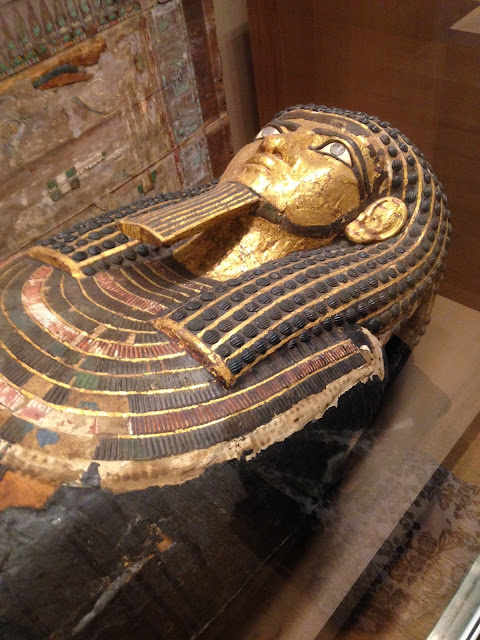Day 419 - Decor and pastels
July 28, 2025
When I walk into gallery 642, I see an odd assemblage of works: four frescos (subsequently transferred to canvas) by Tiepolo and his school that imitate sculpture and depict classical figures representing arithmetic, grammar, geometry, and metaphysics (what is metaphysics, anyway?); a huge Tiepolo oil painting; and three18th-century French portraits. Then I notice that there are two introductory wall signs. The first deals with the role of painters in creating what the sign calls "immersive interiors, " I have only an instinctive sense of what this term means, but the sign points out that many artists were engaged in the design of theater sets, gardens, tapestries, furniture, and interior decor more generally. The second wall sign discusses the use of pastels in 18th century portraiture. This certainly explains the mix of genres. The Tiepolo painting is so immense - maybe 20 feet across and 12 feet high - that it occupies a whole wall of the gallery, whose other walls needed to be filled. At least the curators chose works from the same century.
I look at the big Tiepolo and immediately wonder whether it was intended to be mounted on a ceiling. It's partly the work's size and its irregular shape that lead me to this conjecture - or maybe I've just seen lots of painted ceilings in Italian palazzos. In any case, I'm right. This ceiling, which dates to about 1750, came from the Palazzo Barbaro in Venice, and, appropriately, it's called "The Glorification of the Barbaro Family." In the middle of the composition is a semi-nude woman who stands against the sky holding a horn to her lips in her right hand and an olive branch in her left hand. Beside her reclines a male figure crowned with a laurel wreath; with his left hand, he strokes a diminutive lion. Putti hover in the air, while in the foreground, a woman (?) with a snake wrapped around her forearm points upward, calling our attention to the central personages. The description points out that the painting was never meant to be seen head-on; through its composition and the use of foreshortening, the figures seem to advance and recede against a blue sky punctuated by rosy clouds.
I have no idea whether the figures are allegorical in some way; was the lion a symbol of the Barbaro family, or just of Venice more generally? In any case, it must have been fun, if slightly dizzying, to look up and discover new things in the painting. And the work must have impressed the Barbaros' guests no end. Glorification indeed.
The pastel by Charles Antoine Coypel (yet another artist of whom I've never heard but perhaps should have - he was court painter to Louis XV!) attracts me for the technical skill it displays. Made in 1741 and measuring about 46 inches high and 40 inches wide, it's a double portrait of Francois de Julienne and his wife Marie-Elisabeth. Working in pastels, augmented by black chalk and watercolor, Coypel captured a variety of textures: the velvet of his coat, the fine lace of her sleeves and shiny beads of her bracelet. Although both husband and wife sport powdered hair (or wigs?), they look very young, and in fact, he was 22 and she 19 when the portrait was made. They also look remarkably similar to each other.





Comments
Post a Comment